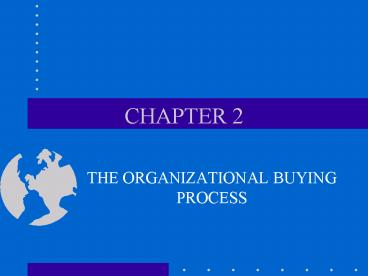THE ORGANIZATIONAL BUYING PROCESS - PowerPoint PPT Presentation
1 / 21
Title:
THE ORGANIZATIONAL BUYING PROCESS
Description:
Objectives of Business Buyers. Availability of Product/service. Reliability of sellers. ... Use your experiences to know who is the powerful buyer. ... – PowerPoint PPT presentation
Number of Views:172
Avg rating:3.0/5.0
Title: THE ORGANIZATIONAL BUYING PROCESS
1
CHAPTER 2
- THE ORGANIZATIONAL BUYING PROCESS
2
Important Topics of the Chapter
- Changing Role of Business Buyer.
- The Business Buying Process.
- Business Buying and Buying Center.
- Environmental Forces and Buying Decision.
3
Objectives of Business Buyers
- Availability of Product/service.
- Reliability of sellers.
- Consistency of quality, delivery and price.
- Decision by business buyers directly effects to
cost and profitability.
4
Changing Role of Buyer
- Relationship marketing
- Alliances and strategic partnership
- understanding the needs
- treating as a partner
- employees are friendly with customers
- providing quality service
- Profile of a business buyer
- 36-45 years old and at least 15 years experience
- have degree in business
- Women are gradually increasing
5
Value Analysis
- Developed by GE in 1940s.
- It aims at studying products and all its
components to improve quality, lower cost with
more stable supply. - It exchanges efficiency and profitability.
- It may be used for vendor cooperation with lower
cost. - Its purpose to secure improved performance with
approach - It cannot be implemented without input from
production, purchasing and marketing.
6
Make-or-Buy Analysis
- It may be generated because of poor vendor
performance. - Ascertaining Profitability
- All cost must be considered such as delivery,
direct labor, purchasing and opportunity - Resources in maximizing production, managerial
and financial capabilities can be formalized - Profitability of the organization is higher
7
Make-or-Buy Analysis(cont.)
- Manufacturing
- Make-or Buy decision will be based upon, if
- Items are required in large volume and suppliers
are unreliable. - They are adopted in manufacturing facility.
- It is cheaper to produce than purchasing from a
vendor. - It is not protected by patent rights.
8
Negotiation
- It is the art of bringing two sides together to
obtain desired objectives. - It is a technique of communicating ideas.
- It represents a structural process related to
quality, quantity, payment term and service. - The both sides should show self-confidence,
self-esteem, courage, flexibility, patience, and
understanding of need satisfaction, tolerance,
and intelligence.
9
Negotiation
- Buyer and Seller Strengths
- The unprepared side may loose the negotiation.
- Buyer and seller must know each other.
- At the end both side must win something and
feeling good. - Differences must be identified and resolved for
complete satisfaction. - Understanding the outcomes may allow negotiators
more flexibility in choosing the negotiation
behavior adopted.
10
The Business Buying process
- Recognizing the need
- Developing Product Specifications
- Soliciting Bids from suppliers
- Making the purchase decision
- Issuing the contract
- Inspecting delivered goods
- Evaluating vender performance
11
Evaluating Potential Vendor
- Performance analysis
- Efficiency, reliability and cost
- Plant visit
- Geographic location
- Capacity
- quality and price requirements
12
Business Buying Situation
- New-Task
- Modified-Rebuy
- Straight-Rebuy
13
The Buying Center
- Users
- Gatekeepers
- Influencers
- Deciders
- Buyers
14
Materials Management Concept
- It is the flow of goods for manufacturing
operations. It expands to raw materials,
component parts, and inventory control along
with being an important tool in planning and
forecasting. - Alternative approaches
- Traditional
- Just-in-time
- Kanban
- Integrated Supply Chain
- Partnering management usually develop between a
purchaser and a distributor on an intermediate to
long-term basis.
15
Environmental Forces and Buying Decision
- Economic Environment
- Derived nature of business demand
- Physical Environment
- Geographic characteristics of region
- The Competitive Environment
- Technological Environment
- Knowledge explosion
- Legal-Political Environment-FDA, FTC
- The Ethical Environment
16
Business Buying Motives
- Businesses are not buying for themselves. They
are buying for their business . Therefore, they
try to - reduce uncertainty in quality and service
- select a supplier with the most favorable value
- use multiple sources
- Use psychology-human side of selling/ buying
17
Behavioral Clues in Buying
- Power and formal authority often go together.
- Communication with the buying-center
power-holders is necessary. - Use your experiences to know who is the powerful
buyer. - The most powerful buying-center members are
probably not easily identified
18
Behavioral Clues in Buying (Cont.)
- No correlation exists between the functional area
of manager and his or her power within the
company.
19
Purchasing Organizations
- Purchasing functions
- what to buy
- in what quantities
- at what time
- from what sources
- with what procedures
- Implementation function
- requisition
- ordering
- receiving and paying
20
Purchasing Organization (Cont.)
- Organization structure
- under the production and manufacturing division
- under the control of top management
- Separate buying department
- Centralized Vs. Decentralized Buying
- Control process
- Independent in decision making
- understanding the differences in needs
- developed goodwill through local distributor
21
Purchasing Organization (Cont.)
- Centralized purchasing
- Standardization becomes easier
- Administrative duplication is eliminated
- Provides faster delivery and lower cost
- Better control over purchasing
- Provides better specialization and expertise in
purchasing

